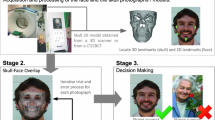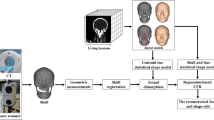Abstract
Craniofacial superimposition is the second stage of a complex forensic technique that aims to identify a missing person from a photograph (or video shot) and the skull found. This specific task is devoted to find the most appropriate pose of the skull to be projected onto the photograph. The process is guided by a number of landmarks identified both in the skull (craniometric landmarks) and in the photograph (cephalometric landmarks). In this contribution we extend our previous genetic algorithm-based approach to the problem by considering the uncertainty involved in the location of the cephalometric landmarks. This proposal is tested over two real cases solved by the Physical Anthropology lab at the University of Granada (Spain).
Access this chapter
Tax calculation will be finalised at checkout
Purchases are for personal use only
Preview
Unable to display preview. Download preview PDF.
Similar content being viewed by others
References
Iscan, M.Y.: Introduction to techniques for photographic comparison. In: Iscan, M.Y., Helmer, R. (eds.) Forensic Analysis of the Skull, pp. 57–90. Wiley, Chichester (1993)
Ballerini, L., Cordón, O., Damas, S., Santamaría, J.: Craniofacial superimposition in Forensic identification using genetic algorithms. Technical report ECSC AFE 2008-03. European Center for Soft Computing (2008)
Cordón, O., Gomide, F., Herrera, F., Hoffmann, F., Magdalena, L.: Ten years of genetic fuzzy systems: Current framework and new trends. Fuzzy Sets and Systems 141(1), 5–31 (2004)
Ballerini, L., Cordón, O., Damas, S., Santamaría, J., Alemán, I., Botella, M.: Identification by computer-aided photographic supra-projection: a survey. Technical report ECSC AFE 2007-04. European Center for Soft Computing (2007)
Nickerson, B.A., Fitzhorn, P.A., Koch, S.K., Charney, M.: A methodology for near-optimal computational superimposition of two-dimensional digital facial photographs and three-dimensional cranial surface meshes. Journal of Forensic Sciences 36(2), 480–500 (1991)
Blickle, T.: Tournament selection. In: Bäck, T., Fogel, D.B., Michalewicz, Z. (eds.) Hand-book of evolutionary computation, ch. 2.3. IOP Publishing Ltd/Oxford University Press (1997)
Eshelman, L.J.: Real-coded genetic algorithms and interval schemata. In: Whitley, L.D. (ed.) Foundations of Genetic Algorithms, vol. 2, pp. 187–202. Morgan Kaufmann, San Mateo (1993)
Bäck, T., Fogel, D.B., Michalewicz, Z. (eds.): Handbook of evolutionary computation. IOP Publishing Ltd/Oxford University Press (1997)
Richtsmeier, J., Paik, C., Elfert, P., Cole, T.M., Dahlman, F.: Precision, repeatability and valida-tion of the localization of cranial landmarks using computed tomography scans. Cleft Palate Craniofac J. 32, 217–227 (1995)
Sinha, P.: A symmetry perceiving adaptive neural network and facial image recognition. Forensic Science International 98(1-2), 67–89 (1998)
Ghosh, A., Sinha, P.: An economized craniofacial identification system. Forensic Science International 117(1-2), 109–119 (2001)
Author information
Authors and Affiliations
Editor information
Editors and Affiliations
Rights and permissions
Copyright information
© 2008 Springer-Verlag Berlin Heidelberg
About this paper
Cite this paper
Ibáñez, O., Cordón, O., Damas, S., Santamaría, J. (2008). Craniofacial Superimposition Based on Genetic Algorithms and Fuzzy Location of Cephalometric Landmarks. In: Corchado, E., Abraham, A., Pedrycz, W. (eds) Hybrid Artificial Intelligence Systems. HAIS 2008. Lecture Notes in Computer Science(), vol 5271. Springer, Berlin, Heidelberg. https://doi.org/10.1007/978-3-540-87656-4_74
Download citation
DOI: https://doi.org/10.1007/978-3-540-87656-4_74
Publisher Name: Springer, Berlin, Heidelberg
Print ISBN: 978-3-540-87655-7
Online ISBN: 978-3-540-87656-4
eBook Packages: Computer ScienceComputer Science (R0)




